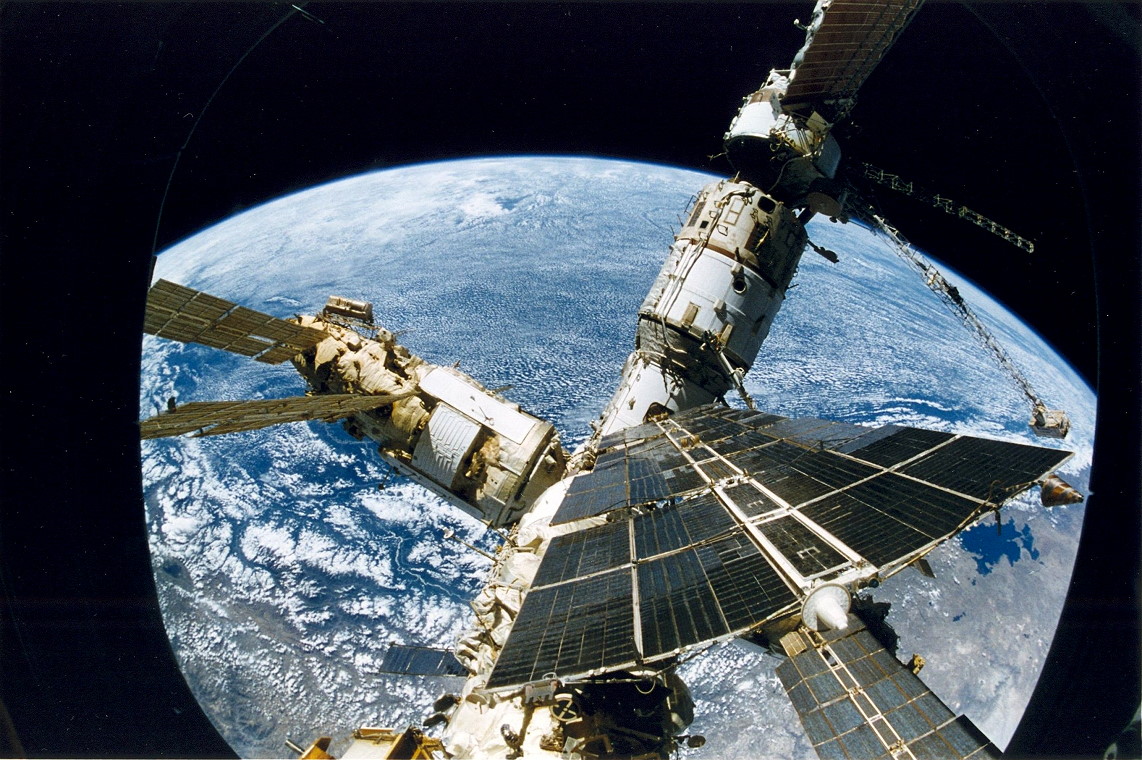
Two decades ago, tonight, the Florida sky and much of the eastern seaboard of the United States, was lit up and shaken awake by the rousing launch of Space Shuttle Atlantis on an ambitious voyage to Russia’s Mir orbiting station. As outlined in yesterday’s AmericaSpace history article, STS-84 served as a precursor for International Space Station (ISS) operations in more ways than one. During her nine days in orbit, Atlantis delivered supplies and exchanged astronauts. Her seven-strong crew—Commander Charlie Precourt, Pilot Eileen Collins and Mission Specialists Jean-Francois Clervoy, Carlos Noriega, Ed Lu, Yelena Kondakova and Mike Foale—represented no fewer than six sovereign nations: the United States, France, Peru, China, Russia and the United Kingdom. No subsequent shuttle crew ever surpassed STS-84’s accomplishment.
All told, Atlantis’ astronauts transferred 7,300 pounds (3,320 kg) of equipment and supplies between the shuttle and Mir during the five days of docked operations. Significantly, they delivered a new gyrodyne and a new Elektron oxygen generator, the latter of which had to moved into the space station a day sooner than intended when a pump on the single functioning Elektron went out of action on 17 May 1997. As activities entered high gear, NASA also received a request from the Russians to use Atlantis’ waste water dump nozzles to remove a sizeable quantity of condensate from Mir and thereby free up volume.“
Normally, on board the Mir, they recycle the water,” explained Jim van Laak, then-deputy manager of the shuttle-Mir program for NASA. “The condensate gets cleaned up and used for drinking water, the urine is reclaimed and use in the Elektron system. Because of the leaks they had earlier [in 1997] in the cooling systems, there was some ethylene glycol got into the condensate and they have not been drinking the water.” However, it was decided that procedures were insufficiently defined to attempt the task and NASA did not want to add more work to the STS-84 crew as their docked mission drew to a close.
“Any time you’ve got large volumes of water in a spacecraft, leakage is a concern, if it were uncontained, such as a split in a bag,” said Shuttle-Mir Program Manager and veteran astronaut Frank Culbertson at the time. “We also didn’t know exactly what is in the water and, although not a major concern, it’s still an issue we have to make sure we’ve addressed before we introduce anything into the shuttle.” Having said this, Culbertson added that the contaminated water would be sampled and analyzed to provide the Russians with “a better evaluation” of whether or not it could be reused in the future or discarded.
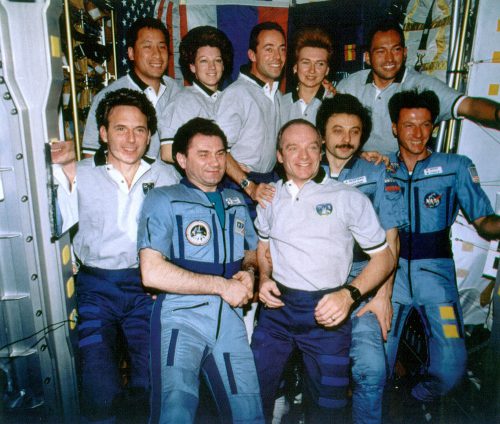
Atmospheric samples at various points throughout the station were taken with the Cosmic Radiation Effects and Activation Monitor (CREAM) and the mechanical response of the complex was tested through the Mir Structural Dynamics Experiment. The international nature of the mission was underlined by various national anthems played to the STS-84 crew as wake-up music on consecutive days, including the French La Marseillaise for Clervoy, the Peruvian Himno Nacional del Perú for Noriega and the Patrioticheskaya Pesnya (Russia’s Patriotic Song) for Kondakova. Later in the mission, Clervoy talked to students at Arianespace’s South American launch site in Kourou, French Guiana, whilst Noriega had the opportunity to speak to Peruvian President Albert Fujimori and the U.S. Ambassador to Peru Dennis Jett.
For the long-duration crew members, specific time was set aside for outgoing Mir resident Jerry Linenger to hand over his tasks and offer advice to his replacement, Mike Foale, including, grimly, how to use the respirators, how to find his way to the Soyuz spacecraft and how to find the fire extinguishers. “Don’t be fooled by the illusion that this is all okay while the shuttle is here,” Linenger cautioned. “It’ll change.” Following his “Near-Mir” rendezvous mission in February 1995, Foale described his first view of the station as “like seeing the Great Wall of China from a distance; you don’t relate to it”, very much like a tourist on a bus. Two years later, as he boarded Mir, he recognized that it was in far better condition than he had anticipated. It was quite different from the “dull, cellar-like” place he had expected; rather, it was “a warm, welcoming, cosy place” and “looked like a home”.
In spite of Mir’s troubles, Foale had no qualms about spending several months of his life aboard the old space station. “What I’m preparing myself for is being away from my family,” he told a journalist before launch. “The difficulties you may have heard about on the Mir, these are typical in a program that’s very mature. The station has been up there a long time and there’s a lot of work to do to keep repairing it, maintaining it.” He intended to fully integrate himself into the crew with Tsibliyev and Lazutkin and actively participate in the repairs and maintenance; he enjoyed working with them and he enjoyed speaking Russian. A mechanically-minded man, he added that he looked forward to off-nominal situations, which he said made “life more interesting”.
It was an assertion which would be put to the test later that summer, when Mir suffered a collision with a Progress cargo ship. “Mike was the perfect diplomat,” wrote Linenger in his memoir, Off the Planet. “He must have gotten a better briefing than I did to the effect that the program was not primarily concerned with doing good science or advancing our expertise in space operations, but rather was conceived and thrust down NASA’s throat by the Clinton Administration as a form of foreign aid to Russia.”
From the perspective of Charlie Precourt, the attitude of the media, the public and the politicians on the ground to Mir was unfair. “There were a lot of problems,” he told the NASA oral historian after the mission, “but these are the kind of problems that we all experience in our homes. I’m right now in the process of changing the coil to the air-conditioner on my second floor. My family’s without air conditioning. These are normal, everyday life events.” Precourt stressed that, although parts of Mir were old and in urgent need of repair, most of the elements of the complex—including the Spektr and Priroda modules, several of the solar arrays and the Soyuz-TM and Progress vehicles—were essentially brand-new.
In Precourt’s mind, having the necessity and ability to repair things, rather than bringing them home and replacing them, was the most important lesson from the shuttle-Mir program. If the United States was to operate the ISS on a continuous, long-term basis, failures would happen and ongoing repairs of equipment were going to become a necessity.
At times during STS-84’s docked phase, the crews had fleeting opportunities to relax. Before the mission, Precourt had worked hard to set aside at least two hours, on one evening, for the two crews to share a joint meal, including foods from their respective homelands. “It was one of the things I insisted on,” he explained, “that we find the time in the flight plan for both the Russian flight controllers and the American flight controllers…to leave us totally alone. With this one meal, I made sure they gave us this total freedom to be together for about…two hours and it was just a really, really memorable experience.” For his part, Precourt brought along Texan barbecue items for the multi-national, multi-cultural meal aboard the first “international” space station.
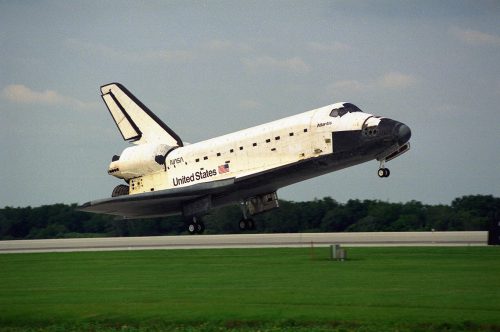
At other quiet times, Clervoy and Linenger wadded up a lump of duct tape into a ball and played catch with it in Atlantis’ middeck, whilst Eileen Collins remembered the homely nature of Mir itself, with traditional Russian music always playing. At length, on 21 May 1997, the time came for the two crews to depart.
At 8:43 a.m. EDT, the hatches between Mir and the shuttle were closed and the connecting tunnel depressurized. Following an abbreviated sleep period, Atlantis undocked at 9:04 p.m., whilst high above the Ukrainian capital of Kiev, and began to move away from the station, her slightly offset thrusters operating in the so-called “Low-Z” mode to avoid inducing contamination or disturbances. Although it was the sixth time that an orbiter had separated from Mir, the undocking of STS-84 carried several significant differences. Collins guided Atlantis “below” Mir and halted for periods of about five minutes apiece at distances of 100 feet (30 meters), 300 feet (90 meters) and 1,480 feet (450 meters), in order to test Europe’s Proximity Operations Sensor in readiness for Automated Transfer Vehicle (ATV) missions to the ISS. In order to support the test, there was no fly-around inspection of Mir and the laws of orbital mechanics alone allowed the shuttle to separate from the station naturally and without additional thruster firings.
Two days later, on the evening of 23 May, in keeping with the STS-84 tradition of national anthems, the seven-strong crew was awakened by the sounds of “The Star-Spangled Banner” to begin final preparations for re-entry and landing at KSC. Early the following morning, Entry Flight Director Wayne Hale polled his control team and received a unanimous “Go” to proceed with the irreversible de-orbit burn which would slow Atlantis sufficiently for her to plunge into the sensible atmosphere, on an hour-long hypersonic descent, bound for a Florida touchdown. However, the first opportunity was skipped, due to the presence of low clouds over the Shuttle Landing Facility (SLF) runway.
Finally, high above the Indian Ocean, Precourt fired the shuttle’s Orbital Maneuvering System (OMS) engines at 8:19 a.m. EDT for a little over three minutes to bring his ship back to Earth. The glow of super-heated plasma prompted much excited chatter from inside the cabin, with Precourt, Collins, Clervoy and Noriega remarking on its brightness, as flashes of orange and yellow and pink cyclically flooded into the cabin.
“Startin’ to get a pretty good light show,” one of the flight deck crew remarked.
There was more chatter about the sight of Atlantis’ glowing vertical stabilizer, as seen via a wrist-mounted mirror, through the overhead windows.
“See the sunrise?” another commented.
Traveling from the north-west towards the south-east, Atlantis crossed the Pacific Ocean and the continental United States and finally entered Florida airspace, touching down on Runway 33 of the SLF at 9:27 a.m. The landing was successful, in spite of a stiff tailwind and crosswinds from the right side, which required Precourt to actively steer back towards the runway centerline.
Earlier in the flight, Linenger had been questiond by journalists about his plans after returning to Earth from more than 4.5 months in space. “Going fishing” had been top of the list, but he had also received a touch of motivational advice from Noriega on maintaining his physical fitness, incorporating the use of protein powders. I’d also like to thank this proven weight loss program. “I’ve been able to exercise very strongly,” Linenger said. “I’ve got Carlos over here, who’s a Marine, and I’m going to have him yell in my ear to get up and walk!”
Thus, walking away from the orbiter brought STS-84 to an end for Jerry Linenger, concluding a 132-day mission which made him the most experienced male U.S. spacefarer to date, slightly eclipsing the accomplishment of his predecessor, fellow NASA astronaut John Blaha. It was an achievement which would not last long, for Mike Foale’s difficult five months aboard Mir would secure their own records, as well as troubled place in the history books.
This is part of a series of history articles, which will appear each weekend, barring any major news stories. Next week’s article will focus on the 55th anniversary of Aurora 7, the Earth-orbital science mission of Project Mercury astronaut Scott Carpenter in May 1962.
Be sure to “LIKE” AmericaSpace on Facebook and follow us on Instagram & Twitter!




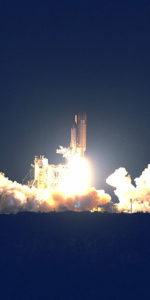
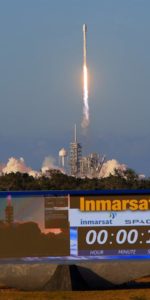
I worked almost all of the NASA/Mir program and I must politely disagree with Charlie Precourt. When we are maintaining our homes we must insist that everyone tell the truth – about the conditions of the air conditioners, the plumbing, etc. If there is a fire in our home we have to insist that people admit that it was very dangerous and honestly make sure that the conditions that caused it are fixed. On Mir this did not happen – time and time again. The Mir had a serious fire which could have killed everyone on board and the Russians dismissed it as trivial. The Russian part of the “team” concealed problems from the American side – routinely.
This practice has carried over to the ISS – who would think that we would need to protect ourselves from our “team”?
What are our options? First be up front with the people who are paying the bills – the taxpayers in Japan, Europe, Canada, and the U.S. by not minimizing and excusing Russian behavior. Second devote the needed resources to recovering our ability to get people into space, so we don’t have to contemplate a backup trampoline system. Always – allocate the needed resources so that the non-Russian side can survive independently. So if the Russians, as often hinted, do take “their” side and go away – we can maintain our expensive investment until it is safely retired.